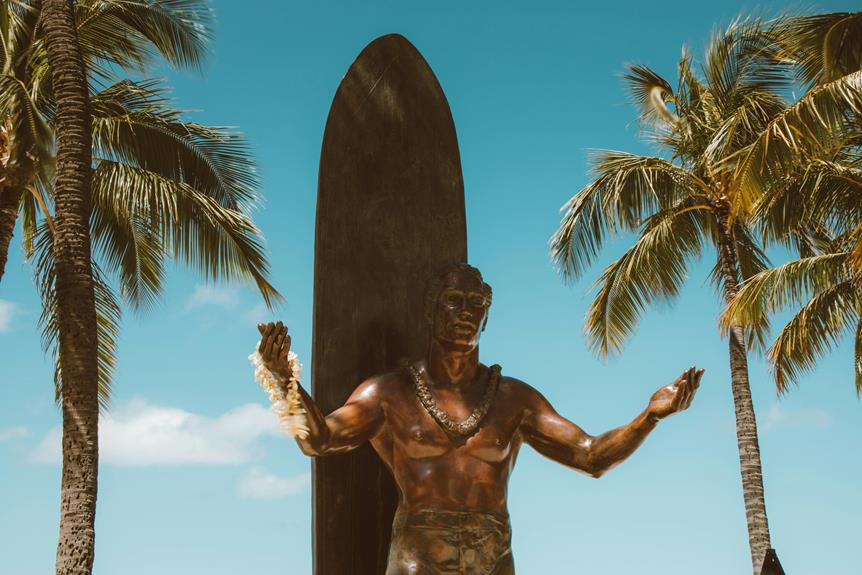You're about to uncover the fascinating transformation of St. Nicholas, a 3rd-century bishop, into the jolly Santa Claus we've come to love today. Born in modern-day Turkey, St. Nicholas was raised in a devout Christian family and became known for his kindness and generosity. As his legend spread, medieval Europeans wove fantastical tales around his life, blending Christian ideals with ancient myths. The Dutch evolved his legacy into Sinterklaas, a gift-giving bishop. Later, American writers and illustrators transformed him into a relatable, jovial persona. As you explore this journey, you'll discover how one man's legacy became a symbol of joy, giving, and community – and there's so much more to this story.
Key Takeaways
- St. Nicholas' medieval legends and folklore merged pagan roots with Christian ideals, influencing the modern image of Santa Claus.
- Dutch traditions transformed St. Nicholas into Sinterklaas, a bearded bishop who brought gifts to children on December 5th.
- Washington Irving's and Clement Clarke Moore's literary works introduced the idea of a jolly, gift-giving figure to the United States.
- Thomas Nast's illustrations brought Santa to life, adding details like a sleigh, reindeer, and a North Pole workshop that became synonymous with the character.
- The Americanization of Santa Claus blended European traditions with American tastes, resulting in a distinctively American version of the character.
Early Life of St. Nicholas
You're likely familiar with the legend of St. Nicholas, but have you ever wondered about the real person behind the myth, specifically his early life and the experiences that shaped him into the iconic figure of today?
Born in the 3rd century in Patara, a small town in modern-day Turkey, St. Nicholas was raised in a devout Christian family. His parents, Epiphanius and Johanna, instilled in him a strong Christian upbringing, which would later influence his charitable deeds.
Growing up near Ancient ruins, St. Nicholas was exposed to a rich cultural heritage, which likely sparked his curiosity and compassion for others. As a young man, he was known for his kindness and generosity, often helping those in need.
His early life experiences, particularly his Christian upbringing, laid the foundation for his future acts of charity and kindness, earning him the reputation as a champion of the poor and vulnerable.
Medieval Legends and Folklore
As St. Nicholas' reputation for kindness and generosity spread throughout the Mediterranean, medieval Europeans began to weave fantastical tales around his life, transforming him into a legendary figure of folklore.
You might be surprised to learn that these stories drew heavily from pagan roots, blending Christian ideals with ancient myths and superstitions.
As a result, St. Nicholas became associated with mystic creatures like the Germanic god Odin and his eight-legged horse, which would later influence the modern image of Santa's sleigh and reindeer.
In medieval Europe, you would've heard tales of St. Nicholas' magical powers, which allowed him to heal the sick, calm stormy seas, and even bring people back from the dead.
His feast day, December 6th, became a time for celebration and gift-giving, as people sought to emulate his kindness and generosity.
These stories not only cemented St. Nicholas' status as a beloved saint but also paved the way for his eventual transformation into the jolly, gift-giving figure we've come to understand today as Santa Claus.
Dutch Traditions and Sinterklaas
In the Netherlands, St. Nicholas' legacy evolved into the beloved figure of Sinterklaas, a bearded bishop who rode a white horse and brought gifts to children on December 5th, the eve of his feast day.
As you imagine Sinterklaas, you picture a jovial figure in traditional costumes, complete with a mitre and a long white beard. You might even envision him riding his horse through the streets, waving to children as he passes by.
To get a sense of the festive atmosphere, imagine the following scenes:
Sinterklaas parades winding through the streets, featuring floats, marching bands, and of course, Sinterklaas himself.
Traditional costumes adorned with intricate lace and velvet, worn by Sinterklaas and his helpers, known as Zwarte Pieten.
Sweet treats like speculaas and pepernootjes, enjoyed by children as they wait for Sinterklaas' arrival.
Gift-filled boats docked along the canals, overflowing with presents for children of all ages.
As you explore the Dutch traditions surrounding Sinterklaas, you'll discover a rich cultural heritage that's full of warmth, joy, and festive spirit.
Washington Irving's Literary Influence
Washington Irving's 1809 book, 'A History of New York,' played a significant role in shaping the American image of Santa Claus, introducing the idea of a jolly, gift-giving figure to the United States.
Irving's work was a product of American Romanticism, a movement that emphasized emotion, imagination, and individualism. His portrayal of Santa Claus tapped into this sentiment, creating a more relatable and endearing character.
Irving's writing also contributed to the Folklore Revival of the 19th century, which sought to preserve and celebrate American folk traditions. By incorporating Dutch folklore and legends into his narrative, Irving helped to legitimize Santa Claus as a symbol of American cultural heritage.
You can see how Irving's literary influence helped to humanize Santa Claus, transforming him from a distant figure into a beloved, benevolent character. His work laid the groundwork for future adaptations and interpretations of Santa Claus, cementing his place in American popular culture.
Clement Clarke Moore's Poem
Clement Clarke Moore's 1823 poem, 'A Visit from St. Nicholas,' popularly known as 'The Night Before Christmas,' further solidified Santa's image in American culture by introducing the idea of a sleigh, reindeer, and a bustling workshop at the North Pole.
As you read the poem, you can't help but be transported to a magical world where the impossible becomes possible. Moore's poetic license allowed him to take creative liberties, shaping the image of Santa in the minds of Americans.
Through his literary mastery, Moore crafted vivid descriptions that evoke a sense of wonder:
Snowflakes gently falling on the roof, creating a serene atmosphere.
Reindeer prancing and pawing, their antlers shining in the moonlight.
Sleigh bells jingling, announcing Santa's arrival.
Stockings hung by the chimney, filled with treats and surprises.
Moore's poem not only added to the mythology of Santa but also created a sense of nostalgia and tradition, making Christmas a more enchanting and festive holiday.
His contribution to the evolution of Santa's image is undeniable, and his poem remains a beloved classic to this day.
Thomas Nast's Illustrations and Impact
Thomas Nast's illustrations, which appeared in Harper's Weekly in the 1860s and 1870s, brought Santa Claus to life in a way that resonated with the American public, cementing his place in the national consciousness.
You might be surprised to know that Nast took some artistic license with his depictions of Santa, adding details that have since become synonymous with the character. For instance, Nast's Santa was a stout, bearded man in a red suit with fur trim, an image that's still widely recognized today.
Through his illustrations, Nast helped solidify Santa's status as a cultural icon. His work didn't just illustrate the character, but also shaped the way people thought about him.
Nast's Santa was a symbol of generosity and kindness, and his illustrations humanized the character in a way that made him relatable to people of all ages.
As a result, Nast's illustrations have had a lasting impact on the way we think about Santa Claus, and continue to influence the way he's depicted in popular culture.
Coca-Cola's Advertising Campaign
As you explore the evolution of Santa Claus, you'll notice a significant impact from Coca-Cola's advertising campaign.
In the 1930s, illustrator Haddon Sundblom's Coca-Cola advertisements featuring a jovial Santa Claus further solidified the character's modern image, forever linking him to the iconic beverage brand.
These ads not only contributed to Brand Revitalization but also cemented Santa's status as an Advertising Icon.
You can almost picture the scenes:
Santa taking a break from gift-wrapping to enjoy a cold Coke by the fireplace.
His rosy cheeks and twinkling eyes shining brightly as he holds up a glass bottle.
A festive holiday setting with Santa at the center, surrounded by Coca-Cola bottles and decorations.
The iconic red and white colors of Coca-Cola blending seamlessly with Santa's signature red suit.
These vivid images have become synonymous with the holiday season, and it's hard to imagine one without the other.
Sundblom's artwork played a significant role in shaping the modern image of Santa, and Coca-Cola's advertising campaign helped to spread that image globally.
19th-Century Americanization Efforts
During the 19th century, American writers, poets, and illustrators played a significant role in reshaping the image of Santa Claus, transforming him into a jovial, gift-giving figure that resonated with American values and culture.
As you explore this period, you'll notice that immigrant assimilation played a significant role in this transformation. European settlers brought their traditions and folklore with them, including the legend of St. Nicholas.
However, as they assimilated into American culture, these stories began to evolve, blending with existing customs and taking on a new identity.
This process of cultural appropriation wasn't unique to Santa Claus. Many European traditions were adapted and modified to fit American tastes and sensibilities.
You'll find that this blending of cultures resulted in a distinctively American version of Santa, one that was more relatable and appealing to the masses.
The 19th-century Americanization efforts not only transformed Santa's image but also helped to popularize the legend, making it an integral part of American holiday traditions.
As you examine this period, you'll discover how these efforts paved the way for the modern Santa Claus that's familiar to us today.
The Image of Santa Evolves
Through the creative works of American writers, poets, and illustrators, the image of Santa Claus undergoes a profound metamorphosis, shedding its European roots to don a more relatable, jovial persona that captivates the American imagination.
As you explore the evolution of Santa's image, you'll notice significant changes in his physical representations.
Rounded belly: Santa's once-lanky figure gives way to a jolly, rotund physique, symbolizing abundance and generosity.
Bright red suit: The traditional bishop's attire is replaced with a vibrant, crimson coat, evoking feelings of joy and festivity.
White beard: Santa's facial hair, once a symbol of wisdom, becomes a snowy white, distinguishing feature of his jovial persona.
Twinkling eyes: His eyes sparkle with kindness, exuding warmth and approachability.
These changes, born from cultural reappropriation, transform Santa into an endearing, relatable figure, deeply rooted in American culture.
As you continue to explore the evolution of Santa Claus, you'll discover how these physical representations have cemented his place in the hearts of people around the world.
A Modern Symbol of Generosity
You now encounter Santa as a modern symbol of generosity, whose very image evokes feelings of warmth and kindness, thanks to the profound transformation that has taken place.
As a cultural icon, Santa embodies the spirit of giving, fostering a sense of community and social responsibility. In today's society, Santa represents a gift economy where selfless acts of kindness are valued and encouraged.
This shift in perception has led to philanthropy trends that focus on the joy of giving rather than material gain.
You see Santa's influence in charity drives, toy collections, and volunteer programs that bring people together to make a difference.
His image inspires individuals to engage in acts of kindness, big or small, and promotes a culture of generosity. As a symbol of hope and compassion, Santa's modern persona encourages you to look beyond your own needs and consider the well-being of others.
Frequently Asked Questions
Was St. Nicholas a Real Person or Just a Mythical Figure?
You're wondering if St. Nicholas was a real person or just a mythical figure. Historical records show he was a 4th-century bishop, but legendary tales of his kindness and generosity have certainly contributed to his mythical status.
How Did St. Nicholas Become Associated With Children and Gifts?
You wonder how St. Nicholas became linked to kids and gifts? Well, his reputation for secretly leaving dowries to save young girls from slavery sparked Gift Giving Traditions, while his Child Advocacy efforts solidified his patronage of children.
Are There Any Other Cultures That Celebrate a Santa-Like Figure?
You're curious about other jolly gift-givers, aren't you? Well, you'll find a French Père Noël, a Japanese Hoteiosho, and many more Santa-like figures spreading cheer globally, each with their unique twist and festive flair!
Did Coca-Cola Really Invent the Modern Image of Santa Claus?
You've wondered if Coca-Cola created the modern Santa image, and the answer is no, but they did play a significant role in popularizing it through their Brand Influence and Advertising Impact, solidifying the jolly old man's image in our minds.
Is Santa Claus Still Revered as a Religious Figure in Any Way?
As you wander through snow-dusted streets, you'll find that, yes, Santa's spiritual essence still shines bright in many hearts, where he's revered as a moral authority, guiding children's behavior and embodying kindness, generosity, and love.
Conclusion
As you reflect on the transformation of St. Nicholas into Santa Claus, you're struck by the contrast between the humble bishop who secretly left gifts and the jolly, gift-giving icon of modern times.
Yet, amidst the commercialization, the essence of St. Nicholas's kindness and generosity remains.
Today, Santa represents the best of human spirit – a symbol of selflessness, love, and joy.
And in the midst of winter's chill, his warm heart continues to inspire us to be better, to give more, and to love unconditionally.


